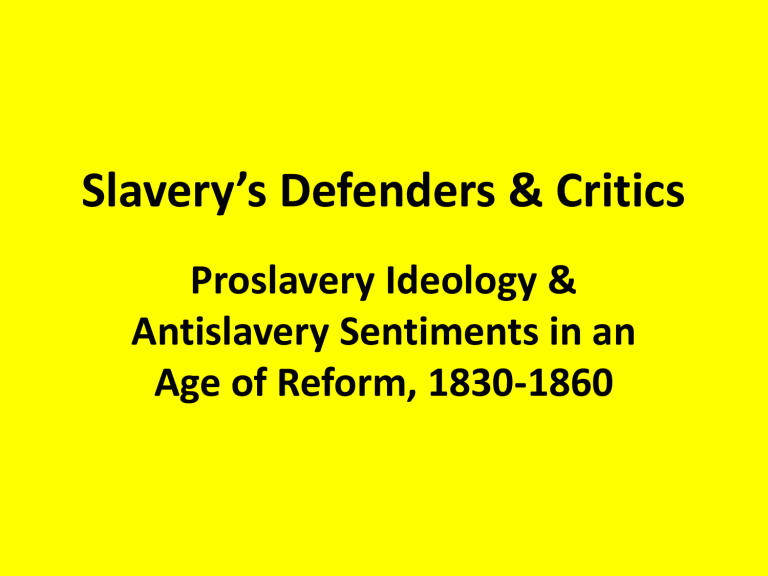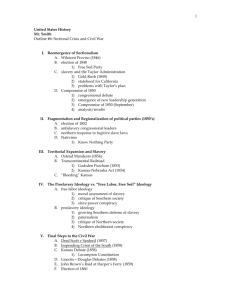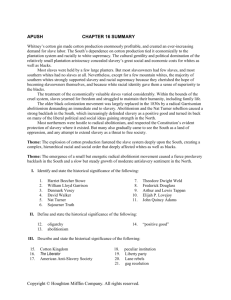Proslavery Ideology - Bakersfield College

Slavery’s Defenders & Critics
Proslavery Ideology &
Antislavery Sentiments in an
Age of Reform, 1830-1860
Market Revolutions
• Eli Whitney & the cotton gin (1793)
• Long vs. short staple cotton
• Industrial textiles
– Lowell, MA
• Slavery revival
• Abolitionism
• Western migration
– Anglos to Texas
King Cotton
• Dark Sweat, White
Gold
• 1815-60: US Cotton makes up ½ all exports
• World supplier of cotton
• 1817: 500K bales
• 1860: 4.8 million
Transportation Revolution
• Significance?
• Widening markets
• Economies of scale
• Interdependency of states
• Passenger travel/migration
• Freedom of mobility
Energy Sources
• Human muscle, horses, oxes, mules
• Food (plants and animals)
• Hay
• Prairie grass: Mississippi
River to Rockies
– Eaten by horses
• Wood: 40 cords per year (North)
• Steam boilers & engines
• Falling water (rivers, streams)
Erie Canal: Albany to Buffalo
• 1817-1825; 350 miles
• New York to New
Orleans: 2 weeks
• Shipping Costs
– 1/10 th land transport
• Passenger travel
The Ambivalence of Thomas Jefferson
• “a necessary evil”
• Slavery & virtue
• Liberty & equality vis-
à-vis slavery
• Notes on the State of
Virginia
• Tyranny for master & slave
From Ambivalence to Defense
• Proslavery Ideology
(1830-)
– Civilizing force
• Christianity & savagism
– Paternalism
• Father & children
• Slavery vs. wage slavery
• Worker’s rights & protections
• Safety net
Proslavery Ideology & Racism
• White supremacy
• Notes on Virginia
– Psuedo-science
• Sambo stereotype
• Regretful runaways
– Rigors of capitalist society
• Wages of whiteness
George Fitzhugh & the Proslavery Argument
(1854)
• Anti-free labor system
• Wage slavery
• Evils of competition
• Southern paternalism vs. Northern greed
• Famine vs. hospitality
• Doc. 67
Slavery, Ideology, and Land Use
• Southern acidic soils
• Fertilizer scarce
• Shifting cultivation regime
– Fallow land
– 67% idle
– Land-hungry
• Northern continuous cultivation
– 35% unimproved
White Non-Slaveholders of the South
• 25% of South owned slaves
– 3% owned 50+ (Great
Planters)
– $1800 prime hand
(1860)
• Dream of owning a slave
– Not competing with free slaves on labor market
– Privilege of skin color
• Doc. 66
Slavery’s Critics
• Runaways
– 1,000 per year
– Underground
Railroad
• Northern states
• Canada
• Fugitive slaves
• Rebellions
– The Amistad (1839)
Slave Rebellion
• Nat Turner’s Rebellion
(1831)
– Virginia
– Divine providence
– 80 slaves, 60 dead whites (women & children
• Doc. 70, Confessions of
Nat Turner (1831)
Antislavery Movements
• Colonization schemes
– Africa, Caribbean,
Central America
– Monrovia, Liberia
– White republic
• William Lloyd Garrison,
The Liberator (1831)
– Militant abolitionism
– Wide publications, North
& South
– Doc. 73
Abolitionist Movement
• Slavery as sin
– unrestrained power
• 250K members
– White urban women
• Northern fringe
– Attack on early feminism
– Proslavery ideology
– Racism
– Whig factory owners
(cotton)
– Political divisive (slavery)
Early Feminism in the United States
• Domestic Ideology
• Reform Impulse
– Temperance
– Anti-Prostitution
– Urban vice
– Prisons & asylums
– Anti-slavery
• Margaret Fuller, New
York Tribune (1844)
Feminism & Antislavery
• Catharine Beecher vs.
Angelina and Sarah
Grimké
• Domestic vs. public sphere
• Slavery of sex
• Doc. 75-76



